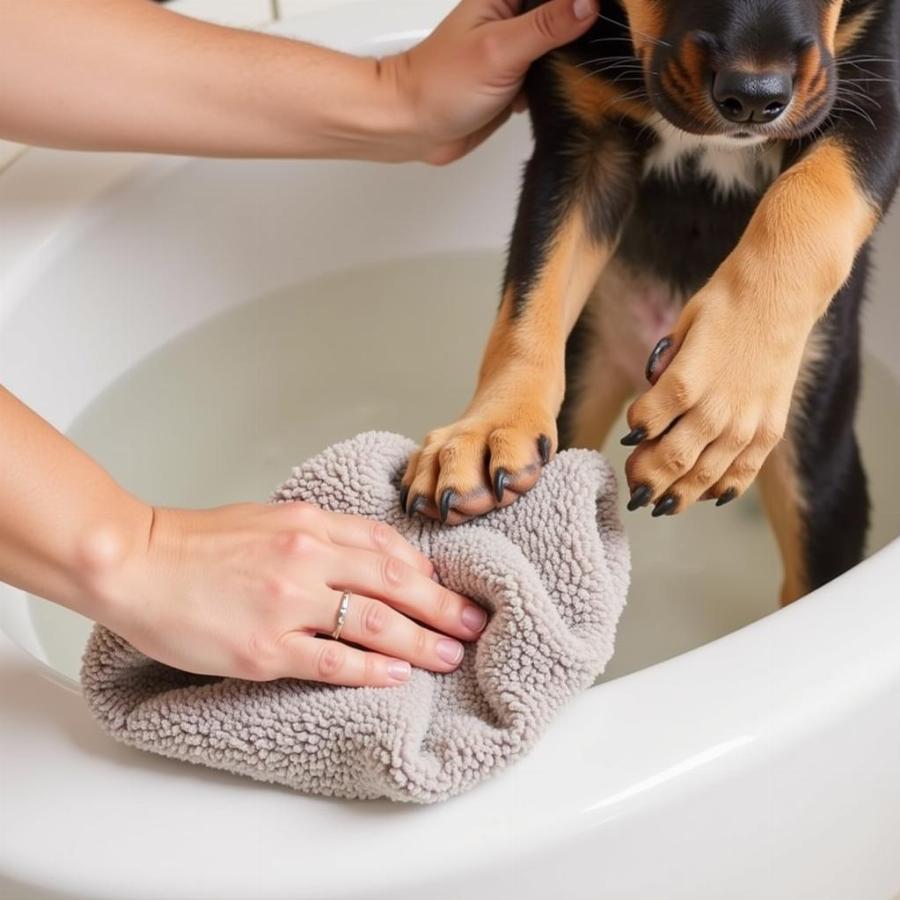Epsom salt and dog paws – a combination you might be curious about, especially if your furry friend is experiencing paw discomfort. Whether it’s itchy paws, dry pads, or minor irritations, many pet owners wonder if Epsom salt soaks can offer relief. This article dives deep into the topic, exploring the potential benefits and risks of using Epsom salt for dog paws, guiding you towards making informed decisions for your canine companion’s well-being.
Understanding Epsom Salt and Its Potential Benefits
Epsom salt, chemically known as magnesium sulfate, is a readily available mineral compound often used for its purported therapeutic properties. For humans, Epsom salt baths are believed to ease muscle aches and reduce inflammation. But what about our four-legged friends? Can Epsom salt offer similar benefits for dog paws?
Some proponents suggest that Epsom salt soaks can help soothe itchy paws, especially those irritated by allergies or environmental factors. The warm water can be relaxing, while the magnesium in Epsom salt may help reduce swelling and inflammation. It can also help draw out splinters or thorns embedded in the paw pad.
Is Epsom Salt Safe for Dogs? The Risks and Precautions
While Epsom salt can offer potential benefits, it’s crucial to understand the risks and take necessary precautions. The biggest concern is ingestion. If a dog licks its paws after an Epsom salt soak, it could ingest a significant amount of magnesium sulfate, leading to diarrhea, vomiting, and even more severe complications.
Another potential risk is skin irritation. While generally considered safe, some dogs may have sensitive skin and react negatively to Epsom salt. Always start with a diluted solution and monitor your dog closely for any signs of discomfort or allergic reaction.
How to Prepare an Epsom Salt Soak for Your Dog
If you decide to try an Epsom salt soak for your dog’s paws, follow these steps:
- Choose a suitable container: A shallow basin or tub is ideal. Ensure it’s clean and large enough to comfortably accommodate your dog’s paws.
- Prepare the solution: Dissolve Epsom salt in warm water. A general guideline is to use 1-2 tablespoons of Epsom salt per gallon of water. However, always consult with your veterinarian for the correct concentration, especially if your dog has any underlying health conditions.
- Soak the paws: Gently place your dog’s paws in the Epsom salt solution. swollen pads on dogs feet can benefit from a 10-15 minute soak.
- Rinse thoroughly: After soaking, rinse your dog’s paws thoroughly with clean water to remove any remaining Epsom salt residue. This is crucial to prevent ingestion.
- Dry the paws: Pat your dog’s paws dry with a clean towel.
 Drying Dog Paws After Epsom Salt Soak
Drying Dog Paws After Epsom Salt Soak
When to Consult a Veterinarian
Epsom salt soaks can provide relief for minor paw irritations, but they are not a substitute for professional veterinary care. If your dog’s paw problems persist or worsen, consult your veterinarian. Conditions like dog foot epsom salt require a proper diagnosis and treatment plan.
Alternative Remedies for Paw Discomfort
Besides Epsom salt, several alternative remedies can soothe your dog’s paw discomfort. These include paw balms, oatmeal baths, and aloe vera gel. For itchy paws dog, identify and address the underlying cause, which could be allergies, parasites, or environmental irritants.
Can I use Epsom salt for my dog’s swollen paw?
Yes, Epsom salt soaks can potentially help reduce swelling in a dog’s paw. However, if the swelling is severe or accompanied by other symptoms like limping or pain, consult a vet immediately. It could be a sign of a more serious issue like a fracture or infection. dogs paw swollen should be examined by a professional for proper diagnosis and treatment.
How often can I give my dog an Epsom salt paw soak?
For minor irritations, an Epsom salt soak can be given a few times a week. However, for more persistent issues, consult your veterinarian for guidance on frequency and concentration. Overuse of Epsom salt can dry out the skin.
Conclusion: Epsom Salt and Dog Paws – Proceed with Caution
Epsom salt soaks can offer potential benefits for dog paws, particularly in soothing minor irritations and swelling. However, it’s crucial to prioritize safety and proceed with caution. Always consult your veterinarian before using Epsom salt on your dog, especially if they have any underlying health conditions. Proper dilution, thorough rinsing, and preventing ingestion are essential for ensuring your dog’s well-being.
FAQs
- Can I use table salt instead of Epsom salt for my dog’s paws? No, table salt is not a substitute for Epsom salt and can be harmful to dogs if ingested.
- What are the signs of an allergic reaction to Epsom salt in dogs? Signs of an allergic reaction can include redness, itching, swelling, or hives.
- Can I use Epsom salt for my puppy’s paws? Consult your veterinarian before using Epsom salt on a puppy.
- My dog licked its paw after an Epsom salt soak. What should I do? Contact your veterinarian immediately.
- How can I prevent my dog from licking its paws after an Epsom salt soak? Use a cone or distract your dog with a toy or treat.